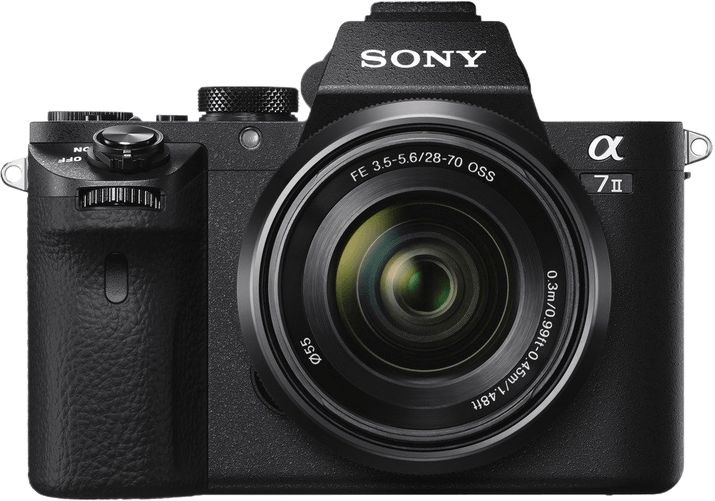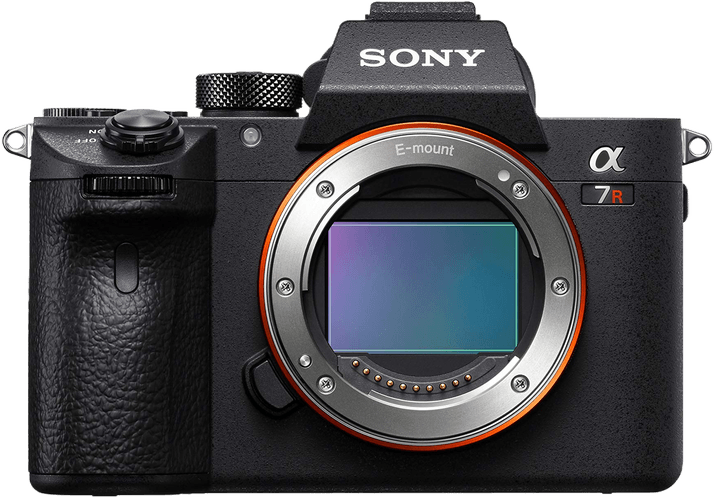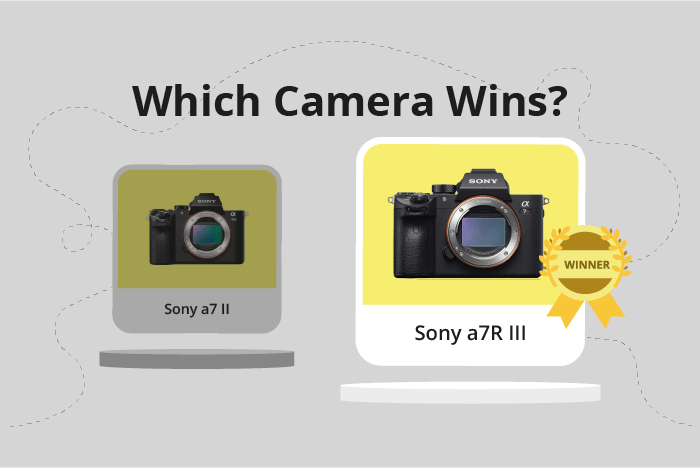Sony a7 II vs a7R III Comparison
Sony a7 II

Sony a7R III

The Sony a7R III emerges as the winner, scoring 83/100, while the Sony a7 II trails behind with a score of 69/100. Both cameras are mirrorless and share the same dimensions of 127 x 96mm, but the a7R III is slightly deeper at 74mm compared to the a7 II’s 60mm. The a7R III is also heavier, weighing 657g versus the a7 II’s 599g.
The a7R III outperforms the a7 II with its higher score, indicating it has better features and performance. However, the a7 II has its advantages, as it was launched at a lower price of $1600 compared to the a7R III’s $3200. This makes the a7 II a more budget-friendly option for those not requiring the enhanced capabilities of the a7R III.
Taking all factors into consideration, the Sony a7R III is the superior camera due to its better features and performance. Still, the Sony a7 II remains a viable choice for those seeking a more affordable option.
Sony a7 II vs a7R III Overview and Optics
The Sony a7R III wins in the optics comparison with a score of 84/100, surpassing the Sony a7 II by 6 points, at 78/100. Both cameras share common specifications, such as a CMOS sensor, Bionz X processor, full-frame sensor size, Sony lens mount, and image stabilization.
The Sony a7R III’s higher score results from its superior specifications, including a 42.4-megapixel count, double the shooting speed at 10 frames per second, and a DXOMARK sensor score of 100. These features contribute to the camera’s enhanced image quality and performance, allowing for greater detail, faster action capture, and improved low-light performance.
On the other hand, the Sony a7 II, while scoring lower, still offers a respectable 24.2-megapixel count and a shooting speed of 5 frames per second. Its DXOMARK sensor score is 90, which, although lower than the a7R III, still provides excellent image quality. This camera may be more suitable for photographers who prioritize portability, affordability, or have less demanding performance requirements.
Considering these points, the Sony a7R III is the better choice for those seeking higher image resolution, faster shooting speeds, and overall superior optics performance. This camera is well-suited for professionals and enthusiasts who demand top-quality results in various shooting conditions. In contrast, the Sony a7 II remains a solid option for those who value a more compact and affordable camera without compromising on image quality. Both cameras cater to different user needs, making them excellent choices within their respective target markets.
Sony a7 II vs a7R III Video Performance
The comparison between the video capabilities of the Sony a7 II and the Sony a7R III reveals a tie, with both cameras scoring 56 out of 100. However, there are notable differences in their video specifications that may sway potential buyers in favor of one camera over the other.
Both the Sony a7 II and the Sony a7R III lack built-in time-lapse functionality. This means that users will have to rely on external tools or software to create time-lapse videos with either camera. Additionally, both cameras have a maximum video frame rate of 30fps at their highest resolution, which is a standard feature for most cameras in this category.
The Sony a7R III has an advantage over the Sony a7 II in terms of video resolution, as it supports 4K video recording with a maximum video dimension of 3840 x 2160. This higher resolution allows for more detailed and sharper videos, making the a7R III a more appealing choice for videographers and filmmakers who require high-quality footage.
On the other hand, the Sony a7 II has a higher maximum video frame rate of 60fps, but only at its Full HD resolution (1920 x 1080). This feature may be beneficial for users who prioritize smooth motion and slow-motion effects in their videos, even at the expense of lower resolution.
Taking these factors into account, the Sony a7R III is the better choice for those seeking higher resolution and detail in their videos, while the Sony a7 II may be more suitable for those who prioritize smoother motion at a lower resolution. Ultimately, the decision will depend on the specific needs and preferences of the user.
Sony a7 II vs a7R III Features and Benefits
The Sony a7R III emerges as the winner in the features comparison with a score of 83/100, while the Sony a7 II scores 57/100. Both cameras share some specifications, including a 3-inch screen size, flip screen functionality, and WIFI connectivity. However, the a7R III outperforms the a7 II in certain aspects.
The a7R III has a higher screen resolution of 1,440,000 dots, compared to the a7 II’s 1,230,000 dots. This results in a crisper and clearer display on the a7R III. Additionally, the a7R III features a touchscreen, which the a7 II lacks. This allows for more intuitive navigation and control on the a7R III. Moreover, the a7R III includes Bluetooth connectivity, enabling seamless pairing with compatible devices for easy sharing and remote control.
On the other hand, the a7 II does not offer any significant advantages over the a7R III in terms of features. It lacks the touchscreen and Bluetooth capabilities found in the a7R III, making it less versatile and user-friendly.
Considering these differences, the Sony a7R III is the superior camera in terms of features. Its higher screen resolution, touchscreen, and Bluetooth connectivity make it a more advanced and convenient option compared to the Sony a7 II. While the a7 II is still a viable choice for photographers, the a7R III’s additional features provide a more enjoyable and efficient user experience.
Sony a7 II vs a7R III Storage and Battery
The Sony a7R III outperforms the Sony a7 II in storage and battery with a score of 65 to 35. Both cameras share similarities in their storage capabilities, accepting SD, SDHC, and SDXC memory cards.
The a7R III excels with its dual memory card slots and compatibility with UHS-II cards, providing more storage and faster data transfer. Its battery life is significantly longer at 650 shots, using the NP-FZ100 battery type.
In contrast, the a7 II has only one memory card slot and a shorter battery life of 350 shots, using the NP-FW50 battery. However, it accepts Memory Stick Duo, Pro Duo, and Pro-HG Duo cards, which the a7R III does not.
Considering these factors, the Sony a7R III is superior in storage and battery performance, while the a7 II offers compatibility with additional memory card types.
Sony a7 II vs a7R III – Our Verdict
Are you still undecided about which camera is right for you? Have a look at these popular comparisons that feature the Sony a7 II or the Sony a7R III:

